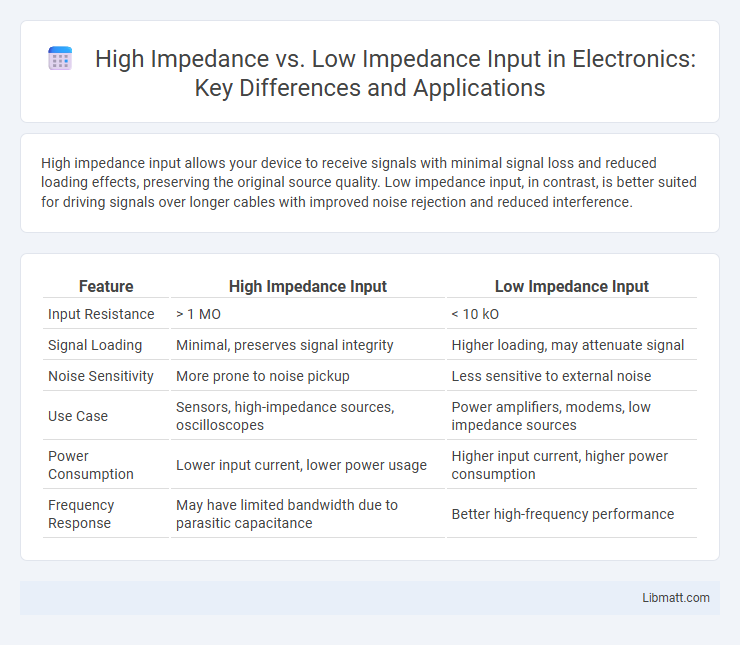High impedance input allows your device to receive signals with minimal signal loss and reduced loading effects, preserving the original source quality. Low impedance input, in contrast, is better suited for driving signals over longer cables with improved noise rejection and reduced interference.
Table of Comparison
| Feature | High Impedance Input | Low Impedance Input |
|---|---|---|
| Input Resistance | > 1 MO | < 10 kO |
| Signal Loading | Minimal, preserves signal integrity | Higher loading, may attenuate signal |
| Noise Sensitivity | More prone to noise pickup | Less sensitive to external noise |
| Use Case | Sensors, high-impedance sources, oscilloscopes | Power amplifiers, modems, low impedance sources |
| Power Consumption | Lower input current, lower power usage | Higher input current, higher power consumption |
| Frequency Response | May have limited bandwidth due to parasitic capacitance | Better high-frequency performance |
Understanding Input Impedance: A Brief Overview
Input impedance refers to the resistance an electronic device presents to an incoming signal, critically influencing signal transfer and quality. High impedance inputs minimize current draw, preserving signal integrity, which is essential for connecting sensitive equipment like microphones or guitars. Understanding whether your device requires high or low impedance input ensures optimal performance and prevents signal loss or distortion.
What is High Impedance Input?
High impedance input refers to an electrical input designed to draw very little current from the signal source, typically in the range of megaohms (MO). This characteristic allows the input to receive signals without significantly loading or altering the original signal, preserving voltage integrity. Understanding high impedance inputs is crucial for applications like audio equipment and measurement devices, ensuring accurate signal capture and minimal interference with Your system.
What is Low Impedance Input?
Low impedance input refers to an input stage in audio or electronic equipment designed to have a low resistance, typically below 600 ohms, which allows better signal transfer and minimizes noise interference. It is commonly used in professional audio gear to ensure compatibility with low impedance sources like microphones and high-quality audio devices. Low impedance inputs provide stable, clean signal reception, preventing signal loss over long cable runs.
Key Differences Between High and Low Impedance Inputs
High impedance inputs typically have resistance values above 1 megaohm, allowing them to interface with high-impedance sources without significantly loading the signal, making them ideal for sensitive audio equipment and instrumentation. Low impedance inputs usually range from 50 to 600 ohms, providing better noise rejection and compatibility with low-impedance sources, such as microphones and professional audio devices. Key differences include signal load effect, noise susceptibility, and source compatibility, which determine the appropriate choice for specific audio and electronic applications.
Impact on Signal Quality and Noise
High impedance inputs minimize signal loading, preserving source voltage and maintaining signal integrity, which is critical for sensitive audio and sensor applications. Low impedance inputs offer better noise rejection by reducing susceptibility to electromagnetic interference and ground loops, thus enhancing signal clarity in electrically noisy environments. Balancing impedance levels ensures optimal signal quality by safeguarding against degradation and external noise contamination.
Applications for High Impedance Inputs
High impedance inputs are essential in applications where signal sources are weak or sensitive, such as in electrochemical sensors, guitar pickups, and medical instrumentation like EEG or ECG devices. These inputs prevent loading the signal source, preserving voltage levels and ensuring accurate measurements or sound reproduction. Your equipment benefits from high impedance inputs by maintaining signal integrity without drawing excessive current or causing distortion.
Applications for Low Impedance Inputs
Low impedance inputs are ideal for applications requiring strong signal integrity and noise immunity, such as professional audio equipment, microphones, and balanced line inputs in recording studios. These inputs can handle long cable runs without significant signal loss or interference, maintaining sound quality in complex audio setups. Your devices benefit from low impedance inputs when precise and clean audio transmission is critical for optimal performance.
Matching Impedance for Optimal Performance
Matching impedance between high impedance sources and low impedance inputs ensures maximum signal transfer and minimizes reflection in audio and RF systems. High impedance inputs draw minimal current, preserving signal integrity from devices like guitars or microphones, while low impedance inputs provide better noise rejection and drive capability for line-level signals. Optimal performance is achieved by selecting input stages that complement the source impedance, maintaining the desired frequency response and dynamic range.
Common Misconceptions About Input Impedance
Common misconceptions about input impedance include the belief that higher input impedance always results in better signal quality, while in reality it depends on the source and application. Many assume low impedance inputs are inferior, but they can provide better noise rejection and stability in certain audio or measurement systems. Understanding the specific use case and source impedance is crucial for selecting the appropriate input impedance to optimize performance.
Choosing the Right Input Impedance for Your Needs
Choosing the right input impedance is crucial for optimizing signal quality and ensuring compatibility with your audio or electronic devices. High impedance inputs, typically above 10 kO, are ideal for sources like electric guitars or passive pickups that require minimal current draw to preserve tone integrity. Conversely, low impedance inputs, generally below 600 O, provide better noise rejection and are well-suited for professional microphones and balanced line-level signals, ensuring your system performs efficiently without unwanted distortion.
High impedance vs Low impedance input Infographic

 libmatt.com
libmatt.com